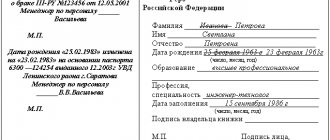If the employee is against
A defined circle of responsibilities once and for all is, unfortunately, a utopia.
Life and production are complex and multifaceted; they constantly pose new challenges that need to be solved, including changing the responsibilities of employees. There is only one goal: increasing the efficiency of the enterprise, minimizing costs and increasing income.
The reasons that most often force an employer to reconsider the responsibilities of his subordinates:
- the state has adopted new regulations, and it is necessary to bring the state into compliance with them;
- changes have occurred in the production process (new technologies, processes, equipment, etc. have appeared);
- the organization of work is changing;
- it is necessary to redistribute responsibilities between employees.
The introduction of new duties into the job description, if they are within the scope of qualifications, does not require the consent of the employee, so disagreements are often possible on this point, especially since wages in such cases are usually not revised. What should an employer do if, in response to his notice of an upcoming change in working conditions, an employee expresses disagreement with working under the new rules?
The employer must offer the person who disagrees in writing another position in accordance with his qualifications, even if it is of a lower rank or less paid, if it is vacant. If there are no such positions or disagreement follows again, the employee has the right to dismiss (clause 7, part 1, article 77 of the Labor Code).
Another option is when the terms of the employment contract are changed unilaterally. According to Part 1 of Article 72 of the Labor Code of the Russian Federation, this can be equated to a transition to a new job, for which the written consent of the employee is required. If the employer insists under threat of dismissal, the subordinate can take the following measures:
- ask in writing for an increase in pay for the new duties assigned;
- if it was not possible to reach an agreement, contact the labor inspectorate or the trade union (you must attach a copy of the main documents and the order imposing new duties);
- In case of illegal dismissal, the court will protect his rights.
So, to impose additional responsibilities, it is better to obtain the consent of the employee, notify him in time and draw up the necessary documents, making changes to the employment contract or job description, and, if necessary, concluding an additional agreement.
Who can be entrusted with temporarily performing the duties of an absent employee?
For various reasons, employees of enterprises and organizations may be absent from their workplace. But the production process should not suffer from this.
In such cases, it is envisaged that the duties of a temporarily absent employee will be assigned to another person. How to arrange this correctly? In this situation, there are subtleties that both the personnel officer and the manager must know.
Attention
And employees will also benefit from raising their educational level. Let's look at how the duties of a temporarily absent employee are assigned, and what each party to the process should focus on.
Options for solving the problem It should be noted that the assignment of duties to a temporarily absent employee is carried out only in accordance with the law. The TC proposes two options for solving the problem.
How to write a job description
1. General Provisions
This section specifies the qualification requirements for the position: level of education, specialization, availability of additional professional training. This also includes requirements for work experience and length of service in this specialty. This section should list (if any) the requirements for special knowledge and skills:
regulatory, computer skills or foreign languages. In addition, this section should provide a list of the main organizational and legal documents and regulations that the employee should follow when performing his job duties. If the position is managerial, the section should provide a list of structural divisions or those employee positions that are directly subordinate to this staffing unit.
2. Job responsibilities
This section must include a complete list of functions performed, taking into account the tasks facing this department. The areas of the employee’s work activity should be described as completely and in detail as possible.
We invite you to read: Universal succession during reorganization
3. Rights
The powers assigned to this position are specified here. They must be specified taking into account the specifics of the position, the job function performed and the responsibilities. In this section you can find a list of documents that define the rights of the employee.
4. Responsibility
This section provides for types of liability for non-compliance by an employee with the provisions of the job description. This section may contain both general references to the Labor Code and specify the procedure for imposing penalties. Remember that all types of disciplinary sanctions for failure to fulfill or improper performance by an employee of labor duties are listed in Article 192 of the Labor Code of the Russian Federation.
This is a reprimand, reprimand and dismissal. For certain categories of employees, laws, charters, and discipline regulations may provide for other types of disciplinary sanctions. But most employers have the right to apply only those types of disciplinary sanctions that are listed in Article 192 of the Labor Code of the Russian Federation.
You can also include sections in the job description:
- “Subordination chart”, where the relationships by position are specified;
- "Possibilities of substitution";
- other sections taking into account the specifics of work in the organization.
1. “Job responsibilities.” This section establishes the main job functions that can be entrusted in whole or in part to an employee holding this position.
2. “Must know.” This section contains the basic requirements for the employee. This indicates special knowledge, knowledge of legislative and regulatory legal acts, regulations, instructions, methods and means that the employee must use in the performance of job duties.
3. “Qualification requirements.” This section determines the level of professional training of the employee necessary to perform the provided job duties and the requirements for work experience.
When additional responsibilities are necessary
Non-standard production situations that require additional obligations to be imposed on employees may be due to the absence of an employee from the workplace, whose responsibilities are transferred to the shoulders of other persons. The reasons for the event may be illness, vacation or medical examination. If the solution to a production problem is within the competence of a specialist who has a specific qualification, a specialty for which is not included in the staffing table, then such obligations can be assigned to an employee who has the appropriate education and skills.
Read more: Anyone can engage in teaching
An increase in the volume of product output, as well as changes in production regulations, may require additional work not previously provided for by the business entity. New responsibilities may be assigned to an employee within the limits of his competence.
It is important to correctly formalize additional responsibilities for the employee in order to eliminate later disputes regarding remuneration and incompetent performance of duties, which the employee may not be aware of.
Documents regulating responsibilities
Logic dictates that these are the ones that will need to be amended when additional responsibilities are assigned.
- Employment contract.
As Part 2 of Article 57 of the Labor Code states, it must indicate the work function of the person being hired - work in one or more specialties within the qualifications. Naturally, a range of specific responsibilities is outlined. If this “circle” somehow changes, the employment contract will have to be adjusted. FOR YOUR INFORMATION! No one can oblige an employee to perform work that is not specified in the employment contract. All actions to change the main document are carried out exclusively with the prior consent of the employee 2 months before the planned changes in response to a written notification to management. - Job description.
The employer can choose the duties it requires from the employee. If the legal conditions set out in the employment contract, and most importantly, the work function, do not change, then the manager has the right to change the job description without taking into account the opinions of employees. IMPORTANT! Managers try to secure the goodwill of subordinates when changing their responsibilities, otherwise cooperation is unlikely to be effective and last long.
There are 2 options for creating a list of responsibilities:
- as an annex to the employment contract - then in case of any changes it will be necessary to conclude an additional agreement to the main document;
- as a local regulatory legal act - you can issue a modified version of the job description and ask the employee to endorse it: this will be evidence of his acceptance of new responsibilities.
We invite you to read: How to terminate a contract with a telecom operator: detailed step-by-step instructions
Legislative regulation
When assigning additional responsibilities to an employee, one should rely on current legislative norms and internal documentation of the enterprise.
The list of responsibilities of each employee is determined by the terms of the employment contract, the elements of which must be reflected in the job description. When preparing documentation, you should take into account the range of responsibilities regulated by a particular profession and the qualification requirements for it.
If there is a production need to perform work that is not taken into account by the internal regulatory documentation drawn up for a specific employee position, it is necessary to make appropriate changes to it. To do this, it is necessary to adjust the documentation regulating labor relations.
The Labor Code defines the rights of each employee of a business entity to work in accordance with the requirements of a formalized agreement with the employer.
He is not authorized to assign additional duties to hired workers without obtaining their consent. To legally make changes to the documentation regulating changes in labor parameters, it is necessary to notify the employee in writing about the planned changes no later than 2 months before their implementation. Adjustments to duties can only be made after receiving the employee’s written consent after two months from the date of the event.
It is worth noting that if, when the list of works is changed, the employee’s functional responsibilities do not change, then the internal documentation of the enterprise can be changed without the consent of the employees. After the internal documentation has been completed and put into effect, employees must be familiarized with the list of obligations set out in the new edition.
Approval of job description
Job descriptions are approved by the head of the organization. The procedure for approving a job description is as follows. The title page bears the stamp “I approve”, the manager’s signature and the date of approval.
In this case, the approval stamp in the upper right corner of the document must consist of the word APPROVED (without quotation marks), the title of the position of the person approving the document, his signature, initials, surname and date of approval2.
Placing the stamp “I approve” and the manager’s signature on the title page of the job description is sufficient for the document to come into force. At the same time, you can additionally issue an order from the manager approving the job description.
Sample order for approval of job descriptions
In order to bring current standards of management documentation into line with new staff positions
I ORDER:
1. Approve new job descriptions by June 1, 2020:
Deputy General Director for Administrative and Economic Affairs;
Leading Logistician of the Logistics Department;
senior HR manager of the HR department;
senior sales consultant of the trading department.
2. Familiarize with the job descriptions of the Deputy General Director for AChP Vasiliev V.V., leading logisticians of the logistics department Sergeev S.S. and Aleksandrov A.A., senior HR managers of the personnel department Semenova S.S., Egorova E.E. and Grigoriev G.G., senior sales consultant of the trading department to Gromov L.L.
3. Appoint HR Director I.I. Ivanov responsible for the execution of this order.
General Director of Romashka LLC ___________ P.P. Petrov 00.00.2015
I have read the order:
HR Director: _______________ I.I.Ivanov
How to register a temporary replacement for an absent employee
Which replacement method should the employer choose: combining positions, increasing the volume of work or temporary replacement? How to formalize the completion of such work and establish additional payment for it? Is it possible not to pay for it at all?
The Labor Code provides for three ways for an employee to perform additional work without being released from the main one: combining positions (professions), increasing the volume of work (expanding service areas), and also performing the duties of a temporarily absent employee (Article 60.2 of the Labor Code of the Russian Federation).
The named methods are united by the fact that additional duties are carried out without interruption from the main job and during the established duration of working hours (shift) (part one of Article 60.2 of the Labor Code of the Russian Federation).
If such work is performed outside the working day, then it will be an internal part-time job (Article 60.1, part one of Article 282 of the Labor Code of the Russian Federation). The employer’s choice of the form of performance of additional duties depends on the nature of the work. In this case, it is necessary to take into account the features of each method.
Combining positions (professions) is the performance by an employee of additional work in another position (profession) (part two of Article 60.2 of the Labor Code of the Russian Federation). An employee cannot combine positions of the same name.
Most often, combination is established when a staff position in an organization is not filled (vacant) for some reason.
An increase in the volume of work (expansion of service areas) is the performance by an employee of additional work in the same profession, but in an amount exceeding that established by the employment contract (part two of Article 60.2 of the Labor Code of the Russian Federation).
For example, if a cleaner, working at one rate, must clean 80 sq. m of space, then, as part of an increase in the volume of work, she can be instructed to clean an additional 20 square meters. m during her main working hours.
Of course, if she is able to cope with such a volume.
Fulfilling the duties of a temporarily absent employee is the performance by an employee of additional work in the same profession or in another (part two of Article 60.2 of the Labor Code of the Russian Federation).
In this case, it is assumed that the replaced employee continues to be registered in the organization, but for some reason is not able to fulfill his duties. In other words, temporary replacement is allowed only for occupied positions and is not allowed for vacant ones.
So, an engineer can temporarily perform the duties of a supply manager while he is on sick leave.
It must be borne in mind that if an acting employee is released from his main job, then this is a temporary transfer to another job (part one of Article 72.2 of the Labor Code of the Russian Federation).
Additional work on the basis of combining, fulfilling the duties of a temporarily absent employee or increasing the volume of work can be assigned to an employee only with his written consent (part one of Article 60.2 of the Labor Code of the Russian Federation).
It must indicate: the name of the position for which additional work will be performed, its content and volume; the amount of additional payment for combining positions (increasing the volume of work, temporary replacement); the period during which the employee will perform additional work.
If the combination of professions is due to the presence of a vacant position in the organization, then the term of work in the additional agreement can be formulated as follows: “The employee is entrusted with performing the duties of an accountant in the order of combining positions with an additional payment of 40 percent of the salary for the combined position from April 7, 2014 until the closure vacant position."
When performing the duties of a temporarily absent employee, when it is impossible to accurately determine the moment of his return to work, the additional agreement with the replacement employee can indicate: “The employee is entrusted with performing the duties of an accountant in the order of combining positions with an additional payment of 40 percent of the salary for the combined position from April 7, 2014 until the absent employee returns to work.”
Based on the concluded agreement, issue an order for the temporary performance of additional duties (sample below). The document must indicate the work being assigned, the deadline for its completion and the terms of payment. Familiarize yourself with the employee’s order against signature (paragraph 10, part two, article 22 of the Labor Code of the Russian Federation).
It should be remembered that information about combining professions, increasing the volume of work (expanding service areas), performing the duties of a temporarily absent employee without release from the main job does not need to be entered into the work book. However, if necessary, they can be added to the employee’s personal card.
Despite the fact that labor legislation does not establish minimum and maximum amounts of additional payment for the temporary performance of additional duties, the employee must be paid for this work.
The amount of additional payment is determined by agreement of the parties and depends on the volume and content of additional work (part two of Article 151 of the Labor Code of the Russian Federation).
We invite you to read: Paid leave must be provided to the employee
The surcharge can be set either as a fixed monetary amount or as a percentage of the tariff rate (salary) or the employee’s salary.
The employer has the right not to pay for additional work if the employee’s employment contract or job description stipulates the obligation to combine his position with the position of a temporarily absent employee with a similar job function.
Such a combination is considered to be performing work under an employment contract, and no additional payment will be accrued to the employee (letter of the Ministry of Health and Social Development of Russia dated March 12, 2012 No. 22-2-897, letter of Rostrud dated May 24, 2011 No. 1412-6-1).
– Temporary performance of additional duties without release from the main job is possible in three forms: combining positions (professions), increasing the volume of work (expanding service areas), as well as performing the duties of a temporarily absent employee.
When combining positions, the employee performs additional work in another position; in case of temporary replacement, both in the same profession and in another. An increase in the volume of work involves working in the same position, but on a larger scale.
– The employer must properly formalize and pay the employee for additional work.
To do this, it is necessary to obtain the written consent of the employee, draw up an additional agreement to the employment contract and issue an order in any form.
There is no need to make an entry in the work book about the temporary performance of additional duties, but this information can be entered into your personal card.
– The additional agreement to the employment contract must contain the following mandatory conditions: the method of assigning responsibilities to the employee to perform additional work (combining or expanding the service area, increasing the volume of work), a list of assigned work. And also the period during which the employee will perform it, the amount of additional payment.
Editorial staff of the magazine ""
Legislation
Replacement of an employee can be carried out in the following cases: the employee uses annual paid leave, unpaid leave, during the period of temporary disability, maternity leave, and in other cases when a temporarily absent employee retains his place of work in accordance with the law.
To replace a temporarily absent employee, in practice, a temporary transfer to another job due to production needs was previously used. Previously, in accordance with Art.
Changes made to the Labor Code of the Russian Federation in 2006 provide for the possibility of using a temporary transfer, both in case of production necessity and in situations not related to it.
In the temporary absence of a specialist, the performance of his job duties can be entrusted either to an employee of the same category - a specialist, or to an employee of a different category - a technical executive or the head of a structural unit.
Replacement schemes, as a rule, are described in practice in job descriptions of specialists and technical performers.
So, for example, the job description of a senior accountant may indicate that during his absence, his duties are performed by a junior accountant, and vice versa - that a senior accountant, during the absence of a junior accountant, performs the duties of the latter.
Example
Is it necessary to indicate in all replacement orders that the employee is appointed acting?
Employees of control and supervisory authorities and contractors can demand the provision of an order that directly states that the employee is appointed acting during the absence of the head of the organization (chief accountant).
In practice, HR departments, when issuing orders for the most important positions, record on a separate line that the employee is acting in the position of a temporarily absent employee, and sometimes they simply write down the order: appoint acting for such and such a position.
The procedure for registering a replacement for a temporarily absent employee depends on the method of replacement.
Example
In one month, due to the long-term illness of the accountant for accounting of settlements with suppliers and contractors (official salary per month - 10,000 rubles), the employee was given an additional payment for filling the position of a temporarily absent accountant for accounting of settlements with suppliers and contractors in the amount of 60 percent of the official salary .
Two ways to assign responsibilities to additional positions
No regulatory documents other than the recommendations of Rostrud say how to draw up job descriptions, so their preparation is voluntary for the employer, and the form is arbitrary. Almost everyone still prefers to draw them up, since this document:
- significantly simplifies the organization of work;
- resolves possible disagreements regarding the work being performed;
- delineates responsibility;
- eliminates duplication of similar functions;
- is compiled not subjectively “for the employee”, but “for the position”, no matter who occupies it.
REFERENCE! When determining the responsibilities of a particular position, the Unified Tariff and Qualification Directory of Works and Professions is taken as a basis. Many of its provisions are outdated, and employers often need new positions that are not reflected in it. In such cases, local executive authorities may adopt regulations on the requirements for a particular position.
Managers can determine the content of the job description themselves, therefore, within the same position, they can add additional responsibilities to it, if such are:
- fit into the qualification characteristics;
- due to technical reorganization of the enterprise;
- caused by changes in working conditions.
IMPORTANT INFORMATION! If the reason for the changes is changes in technical and/or organizational working conditions, the employee must learn about this 2 months in advance (Part 2, Article 74 of the Labor Code). The employee’s consent is not required, but it is his right to be informed in a timely manner.
In all other cases, it is necessary to draw up an additional agreement to the employment contract, providing for the mandatory consent of the employee.
There are various reasons when an employer or employee may need to change the terms of reference. For example, a position is being reduced, and another competent employee agrees to take on a new activity for additional pay. Or the employer wants the employee to perform additional functions for which he has enough working time (for example, a courier can receive calls while in the office).
We suggest you read: Termination of residential lease agreement
The Labor Code of the Russian Federation sets out 2 options according to which an employee can be assigned new responsibilities: internal part-time work and combination work. When choosing the first or second, the employer focuses on whether specific hours can be allocated for additional duties, or whether they are distributed differently during working hours.
The characteristics and differences of these two methods are shown in the table.
| COMBINATION | INTERNAL COLLABORATION |
| Additional duties are performed in parallel with the main job. | Additional duties involve completing the main job first. |
| Working hours do not increase. | Working hours are increased (up to a maximum of half a working day, but not more than 4 hours a day). |
| Payment as agreed with the employer. | Payment is proportional to time worked. |
| An additional agreement to the current employment contract and a change in the job description are required. | It is necessary to conclude another employment contract with this employee - for an additional position at part of the salary. |
| Additional duties can be removed at any time by order of management. | To remove additional responsibilities, you must terminate the relevant employment contract. |
It is up to the employer to decide which method is preferable in a particular situation.
Transfer of powers of the manager during his absence
Early termination of temporary substitution Can an employee prematurely refuse to perform work within the framework of temporary substitution? An employee has the right to early refuse to perform additional work, and the employer has the right to early cancel an order to perform it.
The employee must be notified in writing no later than three working days in advance of early termination of work as a temporary replacement. If an employee wishes to refuse to perform additional work early, he must also notify the employer in writing three working days in advance. This procedure is provided for in Part 4 of Article 60.2 of the Labor Code of the Russian Federation.
Attention
At the same time, placing a slash in front of the position of the main employee or using the preposition “for” is not provided for by current legislation (clause 3.22 of GOST R 6-30/2003, approved by Decree of the State Standard of Russia of March 3, 2003 No. 65-st). If an employee is temporarily transferred to the position of an absent employee, while he performs duties only for this position, then the documents must indicate the position to which he is temporarily transferred.
The exception is the case when an employee is actually transferred to an acting position, provided that such a position is provided for in the staffing table. For example, in connection with vacation, illness, business trip, advanced training, etc. Therefore, in this case, it would be more correct to register namely temporary replacement. When registering a temporary replacement, an additional agreement is concluded, which establishes the amount of the additional payment, which is determined by agreement of the parties to the employment contract (Article 151 of the Labor Code of the Russian Federation). If the duties of a temporarily absent employee are performed outside the main working hours, then internal part-time work is formalized (Art.
In the absence of a full-time authorized deputy manager, an order is issued to temporarily assign managerial responsibilities to such an employee. We recommend that you provide for the procedure for appointing an acting manager in the constituent documents of the legal entity and in the job descriptions of deputy managers. IT IS IMPORTANT!
If the above documents detail the procedure for fulfilling the duties of a temporarily absent manager, then it is not necessary to issue a separate order to assign duties. We should not forget that in order to carry out continuous economic activities of an organization, it may be necessary to issue a card with a sample signature from the bank, which is of a temporary nature (clause 11 of the resolution of the Board of the National Bank of the Republic of Belarus dated 04/03/2009 No. 40).
Yulia Khachaturyan NIKA, RISK PLAN “HR service and personnel management of an enterprise” 2006 Year of publication of the article - 2006. Therefore, please note that the procedure described in the article for registering the performance of duties using unified forms is relevant for those organizations for which they are mandatory .
In fact, not a word is said in the Labor Code of the Russian Federation regarding the institution of assigning the performance of duties. The above-mentioned legal act says a lot about related, practically related concepts: translation and combination.
However, the Labor Code of the Russian Federation requires that the organization maintain accurate records of the time actually worked by all employees and pay for labor. Therefore, if a manager performs his functions during vacation (signs contracts, negotiates with contractors, etc.)
), it is necessary to carry out proper personnel registration of his return to work. Based on the meaning of the regulatory prescription of Art. 125 of the Labor Code of the Russian Federation, if a production need arises for an employee, even if it is the general director, his recall from vacation should be formalized.
There are situations when one of the employees is absent from the workplace for one reason or another. But the enterprise should not change its usual rhythm of work or stop altogether during this time. The way out of this situation would be an order to assign the duties of this employee to someone else.
- You can temporarily transfer one of your colleagues to the position of a currently absent employee.
- Assign his duties to another employee, and he must also do his job.
- Invite someone from outside. He will temporarily replace the main employee.
The choice must be made by the management of the enterprise, and only after that an order on the assignment of responsibilities must be drawn up. Only two factors can influence the decision: labor resources (availability of employees who can perform additional functions) and material capabilities (make partial or full payment).
We suggest you read: Bailiffs wrote off money without notification
If one of the employees is absent from the workplace for some time, then his duties for this period are assigned to another member of the team. This usually occurs due to illness, vacation or business trip. There are two possible solutions to this issue:
- Temporary transfer to the position being replaced. The employee is set a salary for the new profession with all additional payments retained (with the exception of personal allowances). As a result, the amount should in no case be lower than his average salary at his previous place of work.
- Temporary performance of duties along with the performance of their main work. In this case, the amount of payment is determined as a percentage of the salary for the new specialty.
In both the first and second cases, an order on the temporary assignment of duties (or transfer) must be drawn up, which specifies in detail the following information: the period for performing additional duties, the payment due for this work, and the reason for the absence of the main employee.
The specifics of the wording in the order depend on the chosen method of substitution. In general, an order for an enterprise must contain the following data:
- the names of the main position and the one accepted as part of the replacement;
- deadlines for completing additional work;
- the reason for the absence of the replaced employee, if established;
- basis for registration of replacement (number of the concluded additional agreement);
- the amount of the assigned additional payment;
- signatures of the parties on familiarization and agreement with the order.
Limited Liability Company "Perekrestok"
Tula
ORDER No. 14-7
dated February 12, 2020
On the assignment of additional responsibilities in order to combine positions
Due to the absence of senior economist Zarubina E.L. due to undergoing additional training outside of work on the basis of Art. 60.2 and 151 Labor Code of the Russian Federation
I ORDER:
- Instruct economist O.D. Rubinshtein to performing, during the established working day, along with his main duties determined by the pood contract, additional labor functions at the site of Zarubina E.L. as part of expanding the service area.
- Set for Rubinshtein O.D. additional monthly remuneration for performing duties beyond the basic ones in the order of combination in the amount of 75% of the salary of E.L. Zarubina.
- Determine the period for increasing the volume of work by Rubinshtein O.D. from 02/13/2017 to 03/25/2017
BASIS: additional agreement to the employment contract dated February 11, 2017 with O.D. Rubinshtein. from 05/10/2015
General Director of Perekrestok LLC /Gumilenko/ Gumilenko N.P.
The following have read and agreed with the order:
Senior economist /Zarubina/ Zarubina E.L. 02/12/2017
Economist /Rubinshtein/ Rubinshtein O.D. 02/12/2017
Familiarization with the job description
The employee must be familiar with the job description before signing the employment contract (part three of article 68 of the Labor Code of the Russian Federation). If on the date of conclusion of the employment contract the job description has not yet been adopted, the employee must be familiarized with this document immediately after the approval of the job description.
The fact that the employee has familiarized himself with the job description is certified by his signature:
- on a copy of the corresponding LNA (job description). The fact of familiarization can be formalized as follows: “I have read the job description”, date and signature of the employee;
- in a special magazine. This could be a log of familiarization with the organization's LNA or a log of familiarization with job descriptions.
_____________________________________________________
1 letter from Rostrud dated November 30, 2009 No. 3520-6-1
2 clause 3.16 of Gosstandart GOST R 6.30-2003, approved. Resolution of the State Standard of Russia dated 03.03.2003 N 65-st
Job descriptions of employees
Contents of the job description
Analysis of job descriptions
Adjustment of job descriptions
12 personnel documents that will help you pass any audit
Additional responsibilities within one position
The main document regulating the duties of an employee is the Employment Contract.
Legislative norms do not determine the need to prepare a Job Description, so the presence of this document is not required. However, authorized bodies recommend the preparation of such organizational and administrative documentation, since its presence at the enterprise simplifies the organization of work, delineates responsibility and reduces the risk of disagreements regarding assigned obligations.
Since the form and content of the job description are not regulated by law, the document can initially take into account the expanded scope of functional obligations. The content of internal documentation may include:
- qualification requirements;
- an updated list of works that support the economic activities of a business entity;
- actual and planned changes in working conditions.
Many employers are interested in how to assign additional responsibilities to an employee without additional payment. Typically, this procedure is carried out by expanding the list of obligations within one profession.
Employment contract: subtleties that not everyone knows about
In the second method, referring to the requirements of a local regulatory act, which stipulates job responsibilities that specify the content of the labor function, the employment contract also stipulates the need to perform these duties. This conclusion is based on the provisions of part five of Art. 57 of the Labor Code of the Russian Federation, according to which, by agreement of the parties, the rights and obligations of the employee and employer established by labor legislation and other regulatory legal acts containing labor law norms, local regulations, as well as the rights and obligations of the employee and employer arising from terms of the collective agreement, agreements.
This norm is imperative.
Part five of Art. allows you to comply with the requirements of the law without including the entire list of job responsibilities in the employment contract. 57 of the Labor Code of the Russian Federation, according to which the absence in an employment contract of any rights and obligations of the parties to the contract established by labor legislation, other regulatory legal acts containing labor law norms, local regulations, or arising from the terms of a collective agreement, agreements, cannot be considered as refusal to exercise these rights or fulfill these obligations.








